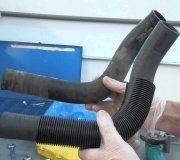The reason:
Testing the coolant pressure
Internal Coolant lost, external coolant lost, white smoke, coolant rising in expansion tank with brownish color, lost of oil, oil level rising, color of oil changing, engine temperature rising (Especially at high speed / freeway). These are all symptom of a head gasket or coolant system failure.
This can be tested with a leak down test and / or a coolant pressure test.
Note: Contrary to popular believe, an engine produce more energy (and heat at the same time) at high speed (freeway) than at idle or slow speed. So more adequate / perfect cooling is needed. Pressure lost often happen in that condition.
TEST #1: Pressure Tests for the Cooling System
The first test of the cooling system is done when the engine is cold. A cooling system pressure tester can be installed in place of the radiator cap. Pressure in the cooling system and hot coolant are not something to be treated lightly. Use caution, and never remove the radiator cap from an engine that has been run even for even a short time. After installing the gauge, pump it up to 10 pounds. Look around for leaks if the gauge shows any pressure loss. Common trouble spots include heads, hoses, water pump and rear heater core. If you smell something sweet when you turn the heater fans on, it may be a coolant leak at one of the heater cores, or simply the O-ring at the rear heater valve leaking. Because there is often more then one leak in the system, it is necessary to continue pressure testing until the system holds pressure.
TEST #2
Start the engine cold with no pressure indicated on the gauge. The pressure in the cooling system builds to aprox 7 lbs at normal running temps looking around for leaks. But if the pressure builds quickly to around 15 lbs the pressure is coming from one of the cylinders through the inner head gasket. This can also show up as a coolant pressure loss in the first test. In extreme cases the cylinder can fill with coolant, and will not turn over. This is know as hydraulic lock, and if you suspect this pull the spark plugs and tries to turn the engine again. Pulling the plugs from the engine allows water to escape from the spark plug holes
SPONSORED LINKS
Tuesday, August 25th, 2009 AT 5:10 AM




